SweetLeef
Well-Known Member
The Soil Food Web
The soil food web is a complex system intertwining and responsible for all life on earth. But I will be pointing this more towards our favorite plant and why it's important if you care about growing organically. Truly, actually organically. Almost all of this information comes from notes I took while watching Jeff Lowenfels lecture on The Soil Food Web (The link is at the end of this report). However, there will probably be some conjecture on my part as well. I am not educated in microbiology, horticulture, botany, or much of anything really. So I am trying to make sure I understand what I am learning as well as make sure that I am sharing information as far and wise as I can.
I will start by saying that I believe if you are using bottled nutrients, even if they are OMRI certified, you are not growing organically. You are growing in a way that while it may be effective, it will never be sustainable as you are harming and eventually killing off the soil food web. Here is why I think that.
Good soil is full of bacteria, archaea, fungi, nematodes, and protozoa. 1 teaspoon of good soil should have 500 million to 1 trillion bacteria and archaea, 3-10 miles of fungal hyphae, and 40-50 nematodes.
A plant sends roots down into the soil in search of food and water. Soil consists of nutrients that need to be broken down in order for the plant to use them. The plant roots secret a kind of fluid called an exudate that attracts a particular bacteria or fungal hyphae to breakdown and make nutrients available for the plant.
Plants use 60-70% of their photosynthetic energy to create and excrete exudates. Think of exudates kind of like our sweat.
Soil is lacking in carbon which the organisms in the soil are seeking out to feed on. The plants exudates are mostly carbon, thus the attraction for the bacteria and fungi. The bacteria and fungi feed on the exudates and in turn give the plant the nutrients it needs.
Bacteria break down sugars, cellulose, things that are easy to digest. Bacteria form a slime, just like the bacterial slime coating your teeth in the morning. The bacteria form this slime when they form colonies. The slim keeps them together and offers a layer of protection to the bacteria.
This slime is important to us growers because it is the building blocks of soil structure. The slime joins and holds particles of soil together. The other reason it is important is it has a PH above 7. It's alkaline. Nitrogen fixing bacteria are most efficient above 7.
Fungi are different than bacteria. Instead of having cell walls made of cellulose or lignin, fungal cell walls are made of chitin (kite-in) making fungus more like a lobster or a crab than a plant or tree.
Fungi produce acids so fungal dominate soil will be below PH 7. In fungal dominate soil nitrogen fixation may be significantly reduced. As a result of the acids, fungi breakdown harder to digest materials like lignin.
There are two important types of fungi in the soil food web. Endomycorrhizal and Ectomycorrhizal. Ecto means outside, Endo means inside.
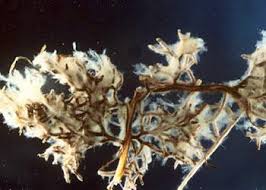
Ectomycorrhiza form a sheath around the roots encapsulating it, feeding off of it's exudates and in turn bringing the plant the nutrients it needs in a form it can use as it needs. The sheath will also act a shied for the roots protecting it from things that may try and eat them. Ectomycorrhiza are visible, and have a fruiting body. Most mushrooms you see are from ectomycorrhiza.
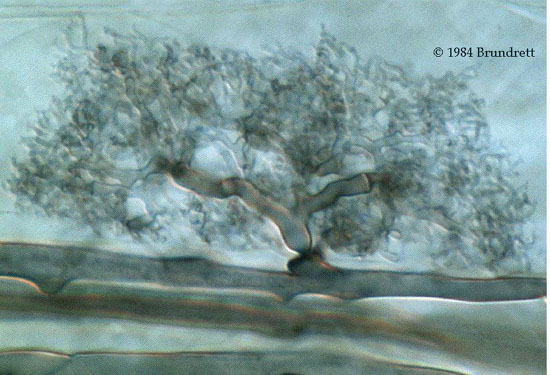
Endomychorriza or Vascular-arbuscular mycorrhizal fungi invade the cell walls through a membrane. They will also act as a vessel holding and moving water and nutrients throughout the system.
The terms for mycorrhizal fungi are often used incorrectly not only by growers, but also on the labels of many mycorrhizal products, and probably by me.
Mycorrhizal - Adjective - Describes the type of fungi; "The fungi is a mycorrhizal fungi."
Mycorrhiza - Refers to the symbiotic relationship between the roots and fungus.
Mycorrhizae - Is the plural of a single root fungus.
What the supplier sells is Mycorrhizal fungi, and what you create is a Mycorrhiza or Mycorrhizae
When a fungi reaches a source of food it needs to break down it does so by secreting acids. Once the fungi or plant has had it's fill it moves on to the next thing it's hungry for. The acids however remain in the soil where the fungi left them and continues to break things down.
Fungi are integral in the creation of soil structure as well. The fungal hyphae spread far and wind through the soil creating a very large network a lot like a subway system. The network of roots will hold the soil together. Parts of the root system will die off and the the leftover material contains nutrients and will leave a space in the soil that can retain water or house bacteria.
Protozoa are "fertilizer spreaders" They feed on bacteria and fungal hyphae and poop out plant ready nutrients. Paramecium will eat 10,000 bacteria a day.
Nematodes are another fertilizer spreader. Nematodes are true worms. An interesting and very gross thing to think about regarding nematodes is that if you disappeared right now, your shape would remain because of all of the nematodes covering your body.
Plants make exudates, bacteria and fungi eat the exudates. Protozoa and nematodes eat the bacteria and fungi and the plants eat the poop from the nematodes and protozoa. The basic cycle in a nutshell.
Nitrogen is Nitrogen
That used to be the common thought but it turns out there is a difference. There are two types of Nitrogen. Nitrogen coms from Nitrates NO3 and Ammonium NH4. Plants can and will use both, but they prefer one or the other.
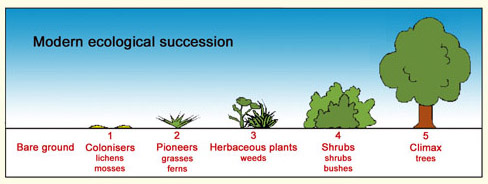
NO3--------------------------------------------------------------------------NH4
The reason why bottles work is because the supply the plant with a very concentrated dose of the nutrients a plant needs to thrive. The problem with that is these bottled nutrients are made of salts. When a salt comes in contact with a nematode, it kills it. Just like putting salt on a slug.
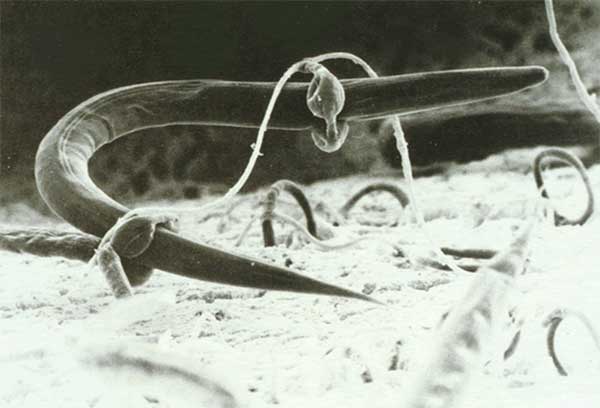
Using bottled nutrients even "organic" nutrients is harmful to the soil food web. After time it will render the soil sterile continuing the need for more nutrients. Killing the soil food web also removes the natural protections from the plant forcing the grower to rely on pesticides, herbicides, fungicides.
Soil Food Web Growers
Don't use pesticides, fungicides, herbicides
Use micro foods, not fertilizers. growers feed the sic robes in the soil using fish, poop, and sometimes fish poop.
If you're not convinced, think about the sequoias and the redwoods. They are the largest plants to ever live on earth. They didn't get that what with bottled nutrients. They got that way because of the soil food web.
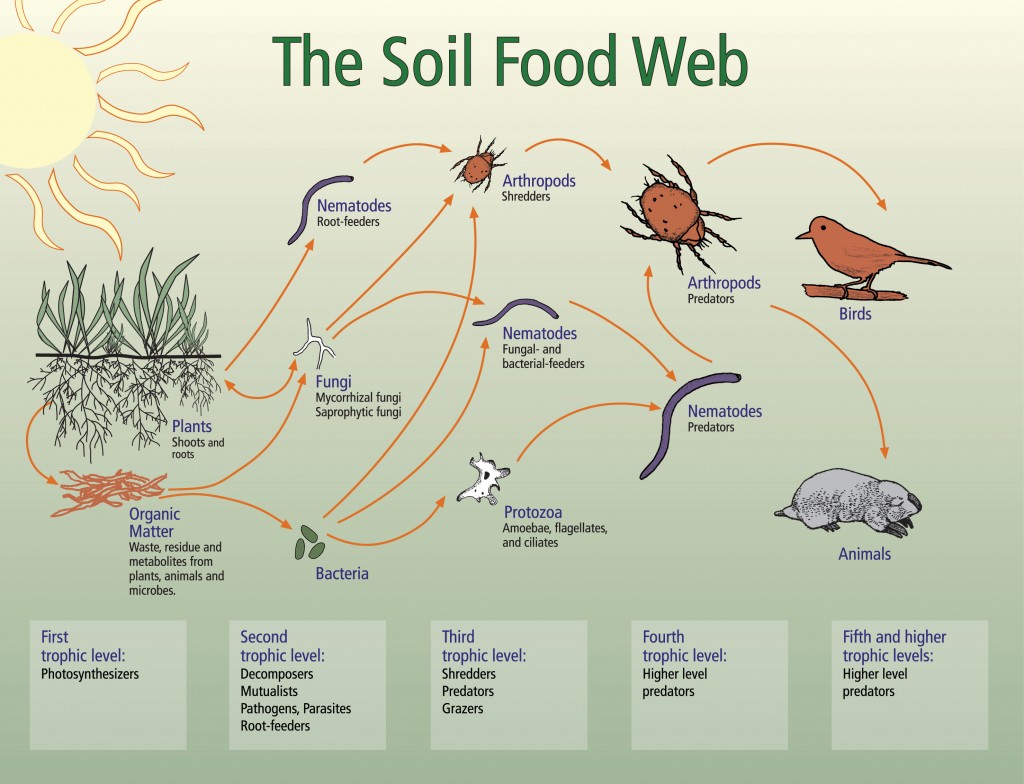
The soil food web is a complex system intertwining and responsible for all life on earth. But I will be pointing this more towards our favorite plant and why it's important if you care about growing organically. Truly, actually organically. Almost all of this information comes from notes I took while watching Jeff Lowenfels lecture on The Soil Food Web (The link is at the end of this report). However, there will probably be some conjecture on my part as well. I am not educated in microbiology, horticulture, botany, or much of anything really. So I am trying to make sure I understand what I am learning as well as make sure that I am sharing information as far and wise as I can.
I will start by saying that I believe if you are using bottled nutrients, even if they are OMRI certified, you are not growing organically. You are growing in a way that while it may be effective, it will never be sustainable as you are harming and eventually killing off the soil food web. Here is why I think that.
Good soil is full of bacteria, archaea, fungi, nematodes, and protozoa. 1 teaspoon of good soil should have 500 million to 1 trillion bacteria and archaea, 3-10 miles of fungal hyphae, and 40-50 nematodes.
A plant sends roots down into the soil in search of food and water. Soil consists of nutrients that need to be broken down in order for the plant to use them. The plant roots secret a kind of fluid called an exudate that attracts a particular bacteria or fungal hyphae to breakdown and make nutrients available for the plant.
Plants use 60-70% of their photosynthetic energy to create and excrete exudates. Think of exudates kind of like our sweat.
Soil is lacking in carbon which the organisms in the soil are seeking out to feed on. The plants exudates are mostly carbon, thus the attraction for the bacteria and fungi. The bacteria and fungi feed on the exudates and in turn give the plant the nutrients it needs.
Bacteria break down sugars, cellulose, things that are easy to digest. Bacteria form a slime, just like the bacterial slime coating your teeth in the morning. The bacteria form this slime when they form colonies. The slim keeps them together and offers a layer of protection to the bacteria.
This slime is important to us growers because it is the building blocks of soil structure. The slime joins and holds particles of soil together. The other reason it is important is it has a PH above 7. It's alkaline. Nitrogen fixing bacteria are most efficient above 7.
Fungi are different than bacteria. Instead of having cell walls made of cellulose or lignin, fungal cell walls are made of chitin (kite-in) making fungus more like a lobster or a crab than a plant or tree.
Fungi produce acids so fungal dominate soil will be below PH 7. In fungal dominate soil nitrogen fixation may be significantly reduced. As a result of the acids, fungi breakdown harder to digest materials like lignin.
There are two important types of fungi in the soil food web. Endomycorrhizal and Ectomycorrhizal. Ecto means outside, Endo means inside.

Ectomycorrhiza form a sheath around the roots encapsulating it, feeding off of it's exudates and in turn bringing the plant the nutrients it needs in a form it can use as it needs. The sheath will also act a shied for the roots protecting it from things that may try and eat them. Ectomycorrhiza are visible, and have a fruiting body. Most mushrooms you see are from ectomycorrhiza.

Endomychorriza or Vascular-arbuscular mycorrhizal fungi invade the cell walls through a membrane. They will also act as a vessel holding and moving water and nutrients throughout the system.
The terms for mycorrhizal fungi are often used incorrectly not only by growers, but also on the labels of many mycorrhizal products, and probably by me.

Mycorrhizal - Adjective - Describes the type of fungi; "The fungi is a mycorrhizal fungi."
Mycorrhiza - Refers to the symbiotic relationship between the roots and fungus.
Mycorrhizae - Is the plural of a single root fungus.
What the supplier sells is Mycorrhizal fungi, and what you create is a Mycorrhiza or Mycorrhizae
When a fungi reaches a source of food it needs to break down it does so by secreting acids. Once the fungi or plant has had it's fill it moves on to the next thing it's hungry for. The acids however remain in the soil where the fungi left them and continues to break things down.
Fungi are integral in the creation of soil structure as well. The fungal hyphae spread far and wind through the soil creating a very large network a lot like a subway system. The network of roots will hold the soil together. Parts of the root system will die off and the the leftover material contains nutrients and will leave a space in the soil that can retain water or house bacteria.
Protozoa are "fertilizer spreaders" They feed on bacteria and fungal hyphae and poop out plant ready nutrients. Paramecium will eat 10,000 bacteria a day.
Nematodes are another fertilizer spreader. Nematodes are true worms. An interesting and very gross thing to think about regarding nematodes is that if you disappeared right now, your shape would remain because of all of the nematodes covering your body.
Plants make exudates, bacteria and fungi eat the exudates. Protozoa and nematodes eat the bacteria and fungi and the plants eat the poop from the nematodes and protozoa. The basic cycle in a nutshell.
Nitrogen is Nitrogen
That used to be the common thought but it turns out there is a difference. There are two types of Nitrogen. Nitrogen coms from Nitrates NO3 and Ammonium NH4. Plants can and will use both, but they prefer one or the other.

NO3--------------------------------------------------------------------------NH4
The reason why bottles work is because the supply the plant with a very concentrated dose of the nutrients a plant needs to thrive. The problem with that is these bottled nutrients are made of salts. When a salt comes in contact with a nematode, it kills it. Just like putting salt on a slug.

Using bottled nutrients even "organic" nutrients is harmful to the soil food web. After time it will render the soil sterile continuing the need for more nutrients. Killing the soil food web also removes the natural protections from the plant forcing the grower to rely on pesticides, herbicides, fungicides.
Soil Food Web Growers
Don't use pesticides, fungicides, herbicides
Use micro foods, not fertilizers. growers feed the sic robes in the soil using fish, poop, and sometimes fish poop.
If you're not convinced, think about the sequoias and the redwoods. They are the largest plants to ever live on earth. They didn't get that what with bottled nutrients. They got that way because of the soil food web.






 You write really well and you're good at breaking down info + reps for sure
You write really well and you're good at breaking down info + reps for sure 


